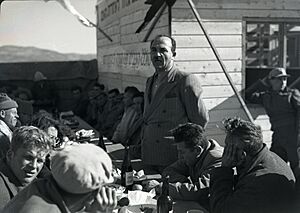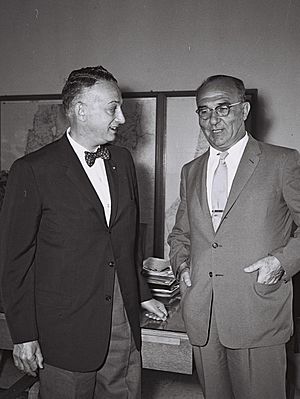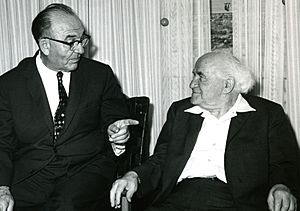Levi Eshkol facts for kids
Quick facts for kids
Levi Eshkol
|
|
|---|---|
| לֵוִי אֶשְׁכּוֹל | |

Eshkol in 1963
|
|
| 3rd Prime Minister of Israel | |
| In office 26 June 1963 – 26 February 1969 |
|
| President | Zalman Shazar |
| Preceded by | David Ben-Gurion |
| Succeeded by | Yigal Allon (Acting) |
| 3rd Minister of Defense | |
| In office 26 June 1963 – 5 June 1967 |
|
| Prime Minister | Himself |
| Preceded by | David Ben-Gurion |
| Succeeded by | Moshe Dayan |
| 2nd Minister of Finance | |
| In office 25 June 1952 – 26 June 1963 |
|
| Prime Minister | David Ben-Gurion Moshe Sharett |
| Preceded by | Eliezer Kaplan |
| Succeeded by | Pinchas Sapir |
| Leader of Mapai | |
| In office June 1963 – 23 January 1968 |
|
| Preceded by | David Ben-Gurion |
| Succeeded by | Himself (as Leader of Israeli Labor Party) |
| Leader of Israeli Labor Party | |
| In office 23 January 1968 – 26 February 1969 |
|
| Preceded by | Himself (as Leader of Mapai) |
| Succeeded by | Golda Meir |
| Member of the Knesset | |
| In office 20 August 1951 – 26 February 1969 |
|
| Personal details | |
| Born |
Levi Yitzhak Shkolnik
25 October 1895 Orativ, Kiev Governorate, Russian Empire |
| Died | 26 February 1969 (aged 73) Jerusalem |
| Cause of death | Myocardial infarction |
| Resting place | Mount Herzl, Jerusalem, Israel |
| Citizenship | |
| Political party | |
| Other political affiliations |
Alignment (1965–1968) |
| Spouses |
Rivka Maharshak
(m. 1922; div. 1927)Elisheva Kaplan
(m. 1930; died 1959)Miriam Zelikowitz
(m. 1964) |
| Children | Noa Dvora Tamma Ofra |
| Signature |  |
| Military service | |
| Branch/service | Jewish Legion (1918–1920) Haganah (1920–1948) |
Levi Eshkol (born Levi Yitzhak Shkolnik; 25 October 1895 – 26 February 1969) was an important Israeli leader. He served as the third Prime Minister of Israel from 1963 until he passed away in 1969. He was also a founder of the Israeli Labor Party.
Before becoming Prime Minister, Eshkol held many other important jobs. He was the Minister of Defense from 1963 to 1967 and the Minister of Finance from 1952 to 1963.
Levi Eshkol became Prime Minister after David Ben-Gurion resigned. He then led his party to win the 1965 elections, staying in office for six years. Early in his time as Prime Minister, Eshkol made big changes. He ended military rule over Israeli Arabs. He also made a successful trip to the United States, being the first Israeli leader invited to the White House. His good relationship with American President Lyndon B. Johnson was very important for Israel and later for the Six-Day War.
Eshkol was involved in the Zionist movement from a young age. He moved to Palestine in 1914 and worked in farming. He helped create major Israeli groups like the Histadrut (a workers' union) and Haganah (a defense organization). He also led the Mekorot water company, making sure people had water. Eshkol was elected to the Knesset (Israel's parliament) in 1951 and quickly took on key government roles.
He led the Israeli government during and after the Six-Day War. Levi Eshkol was the first Israeli Prime Minister to die while still in office.
Contents
Biography of Levi Eshkol
Early Life and Education
Levi Eshkol was born Levi Yitzhak Shkolnik in a small town called Oratov in what is now Ukraine. His parents were both Jewish. His mother came from a Hasidic background, and his father from a Mitnagdim family. Both families ran businesses, including farms and factories.
Eshkol started learning about Jewish traditions at age four. He began studying the Talmud when he was seven. He also had private teachers for general subjects. In 1911, he went to a Jewish high school in Vilna (now Vilnius, Lithuania).
In Vilna, Eshkol joined a student group called Zeiri Zion (Youth of Zion). This started his involvement with the Zionist movement, which aimed to create a Jewish homeland. In 1913, he joined the Hapoel Hatzair party.
Moving to Palestine and Early Public Work
In 1914, Eshkol moved to Palestine, which was then part of the Ottoman Empire. He first lived in Petach Tikva and worked on farms, helping to build irrigation tunnels. He was known as a very good worker. He quickly became active in public life and was chosen as a member of the local workers' union.
During World War I, he joined the Jewish Legion and served there until 1920. In September 1920, Eshkol was one of the 25 people who founded Kibbutz Degania Bet. This became his home, but he often left for important public missions.
In 1920, he helped create the Histadrut, a major workers' organization. He also helped found the Haganah, which was a Jewish defense group. He was part of the Haganah's first national leadership team. In 1929, he became a delegate to the Zionist Congress and was elected to the Jewish Agency.
From 1933 to 1934, Eshkol worked in Berlin for the World Zionist Organization. He helped negotiate the Haavara Agreement, which allowed some Jews to leave Germany and bring their money to Palestine. When he returned to Palestine in 1934, he became the director of Nir company, which helped fund new farming settlements.
Leading the Mekorot Water Company
Eshkol believed a national water company was very important. He worked on this idea from around 1930. The Mekorot water company was finally created in 1937. It was managed by the Jewish Agency, Histadrut, and the Jewish National Fund.
Eshkol was the director of Mekorot until 1951. He helped the company grow, bringing water to farms and homes. By 1941, they built the first water lines to the southern Negev desert. By 1947, over 200 kilometers of water lines were working.
Political and Military Roles (1940s)
Eshkol served again in the Haganah's leadership from 1940 to 1948. He was in charge of the organization's money and helped buy weapons for the Haganah before and during the 1948 Arab–Israeli War.
During World War II, Eshkol encouraged Jewish people to join the British military. Later, he supported fighting against the British Mandate in Palestine. In 1945–46, he represented the Haganah in the Jewish Resistance Movement.
From 1944 to 1948, he was the Secretary General of the Tel Aviv Workers' Council. In 1947, he was appointed to two major defense groups: the Negev Committee and the general Defense Committee. Later that year, David Ben-Gurion asked him to lead the national recruitment center. This group helped create the Israel Defense Forces when Israel became independent in May 1948. Eshkol then became the Director-General of the Ministry of Defense until January 1949.
Becoming a National Political Leader
During the time of mass immigration to Israel (1949–1950), Eshkol led the Settlement Department in the Jewish Agency. He suggested settling many new immigrants on new farms to help them find homes. He believed that a "desolate country" and a "desolate people" could help each other grow.
Eshkol was elected to the Knesset (Israel's parliament) in 1951 as a member of the Mapai party. He served as Minister of Agriculture until 1952.
In the 1959 elections, Eshkol helped organize Mapai's campaign. He also became chairman of the party's social affairs committee. When there were problems within the party, Eshkol was asked to help solve them. In 1961, Ben-Gurion wanted to retire as prime minister and suggested Eshkol as his replacement. However, Ben-Gurion stayed on. Eshkol then helped Ben-Gurion form a new government by negotiating with other parties.
Minister of Finance
After Eliezer Kaplan passed away, Eshkol became the Finance Minister. He held this job for 12 years. During this time, he helped create the Ministry of Finance and set up important departments. In 1954, he helped pass laws to create the Bank of Israel.
Eshkol also oversaw the plan for economic growth that had been started by Kaplan. He helped finalize the Reparations Agreement between Israel and West Germany, which was signed in September 1952. This agreement provided money to Israel from Germany.
In 1957, he began talks with the European Economic Community (now the European Union) to connect Israel's market with theirs. This led to the first trade agreement between them in 1964. In 1962, Eshkol introduced a new economic plan for Israel.
Leading the Party
As Finance Minister, Eshkol became a very important person in the Mapai party. Prime Minister David Ben-Gurion even chose him as his successor.
When Ben-Gurion resigned in June 1963, Eshkol was chosen as the new party leader and then became Prime Minister. However, his relationship with Ben-Gurion became difficult. Ben-Gurion wanted to keep investigating an old Israeli secret operation in Egypt. Eshkol disagreed.
Ben-Gurion tried to challenge Eshkol's leadership in 1965 but was not successful. Ben-Gurion then left Mapai and formed a new party called Rafi. Meanwhile, Mapai joined with another party to form the Alignment, with Eshkol as its head. The Alignment won the elections in November 1965, making Eshkol the clear leader of the country.
Even so, Ben-Gurion, as Israel's founder, continued to criticize Eshkol. He said Eshkol was not strong enough to handle Israel's security problems. As party chairman, Eshkol helped create the Alignment in 1964. He also helped form the unified Israel Labor Party in 1968.
Prime Minister of Israel
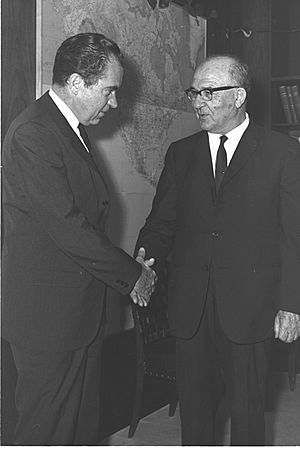
Eshkol formed Israel's twelfth government in 1963. During his first years in office, Israel's economy grew steadily. A big achievement was the opening of the National Water Carrier system in 1964, which brought water across the country.
Later, Eshkol and Finance Minister Pinchas Sapir tried to slow down the economy, which was growing too fast. This caused a temporary economic slowdown and higher unemployment in 1966. However, this slowdown helped fix some basic economic problems and led to a strong recovery later on.
As Prime Minister, Levi Eshkol also fulfilled a wish of Ze'ev Jabotinsky, an important Zionist leader. He arranged for Jabotinsky's body and his wife's body to be brought to Israel and buried in Mount Herzl Cemetery.
Improving Foreign Relations
During his first months as Prime Minister, Eshkol worked to improve Israel's relationships with other countries. He established diplomatic relations with West Germany in 1965. He also worked on cultural ties with the Soviet Union, which allowed some Soviet Jews to immigrate to Israel.
Eshkol was the first Israeli Prime Minister to be officially invited for a state visit to the United States in May 1964. He signed an agreement with the US about Israel's nuclear abilities, stating that Israel would not be the first country to "introduce" nuclear weapons to the Middle East.
The Six-Day War
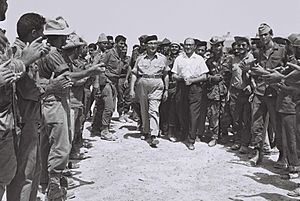
The strong relationship Eshkol built with US President Johnson was very important. It helped Israel get political and military support from the US during the time leading up to the Six-Day War in June 1967.
Some people thought Eshkol was too slow to act before the war. However, his careful approach helped Israel gain international support. Egyptian President Nasser's actions created more diplomatic support for Israel. Eventually, Eshkol formed a National Unity Government, bringing in Menachem Begin's party. He also gave the Defense Minister job to Moshe Dayan.
Death and Funeral
After the Six-Day War, Eshkol's health slowly got worse. He had a heart attack on 3 February 1969 but recovered and returned to work. However, in the early morning of 26 February, he had another fatal heart attack. He passed away at the age of 73 while still in office.
Eshkol was buried on 28 February at Mount Herzl in Jerusalem. He was the first prime minister to be buried in the Great Leaders of the Nation Plot.
Eshkol had wanted to be buried at his Kibbutz, Deganya Bet. But after he died, the government decided he should be buried in Jerusalem. This decision was symbolic after the Six-Day War. It was also easier to hold a state funeral in Jerusalem during winter and safer due to ongoing conflicts. The Eshkol family agreed to the government's request. The government declared two days of national mourning.
Eshkol's body was placed at the Prime Minister's residence with an honor guard. On 27 February, it was moved to the Knesset plaza so the public could pay their respects. An official state ceremony was held on 28 February before the funeral procession to Mount Herzl.
Personal Life and Family
Eshkol was married three times and had four daughters:
- His first marriage was to Rivka Maharshak. They had a daughter named Noa. They divorced in 1927.
- Eshkol married his second wife, Elisheva Kaplan, in 1930. They had three daughters: Dvora, Tama, and Ofra. Elisheva passed away in 1959.
- In 1964, he married Miriam, who worked as a librarian. She was 35 years younger than him and passed away in 2016.
His eldest daughter, Noa, did not marry. From his second marriage, Eshkol had eight grandchildren. His daughter Dvora had three sons, including Professor Sheizaf Rafaeli. His daughter Tama married Avraham Shochat, who later became Minister of Finance, and they had three children. His youngest daughter Ofra had two sons, including the author Eshkol Nevo, who was named after Levi Eshkol.
Eshkol had three siblings. His brother Ben-Zion Shkolnik moved to Israel in 1964. Two other brothers, Lippa and Emanuel, stayed in the Soviet Union. Emanuel Shkolnik died fighting in the Second World War while serving in the Red Army.
Public Recognition and Legacy
Honors and Awards
Eshkol received honorary citizenships from many towns and cities in Israel and other countries. These included Philadelphia (1964), Chicago (1964), El Paso (1964), Tirat Carmel (1965), Kiryat Gat (1965), Nazareth Ilit (1965), Beer Sheva (1965), Beit Shean (1965), Afula (1965), Dimona (1967), Ashdod (1968), Jerusalem (1968), and Petach Tikva (1968).
He also received honorary doctorates (special degrees) from several universities. These included the Hebrew University of Jerusalem (1964), Roosevelt University (1964), Yeshiva University (1964), University of Liberia (1966), and Hebrew Union College (1968).
Commemoration and Memory
Since 1970, Yad Levi Eshkol is the official organization that remembers Prime Minister Eshkol. It teaches about his life, keeps his papers and personal records, and supports research about him. Since 2016, it also runs the historic building in Jerusalem that used to be the Prime Minister's residence. It is now a visitor center in Eshkol's memory.
Many places in Israel are named after him:
- The Eshkol Regional Council in the north-western Negev desert.
- Eshkol National Park near Beersheba.
- Eshkol Power Station, an important power plant.
- Eshkol Water Filtration Plant, the main water filter for the National Water Carrier.
Streets and neighborhoods are also named in his honor, like the Ramat Eshkol neighborhood in Jerusalem. Several schools, including HaKfar HaYarok, are named after him. The Hebrew University of Jerusalem named its Agriculture Faculty after Levi Eshkol and created a research institute in his name.
In 1970, Israel issued a postage stamp with Eshkol's picture. In 1984, his image was chosen for the five-thousand old Israeli shekel bill. In 1985, it was replaced by the five new Israeli shekel bill. Since 1990, his image has been on a special five new Israeli shekel coin.
Gallery
-
With U Nu, 1955
-
With Senator Robert F. Kennedy, 1960
-
With Cheddi Jagan, 1961
-
With Shimon Peres
-
With Mrs. Eshkol and Adlai Stevenson, 1964
-
With Jomo Kenyatta, 1966
-
With Yitzhak Rabin, 1966
-
With Richard Nixon on January 10, 1968
See also
 In Spanish: Levi Eshkol para niños
In Spanish: Levi Eshkol para niños


